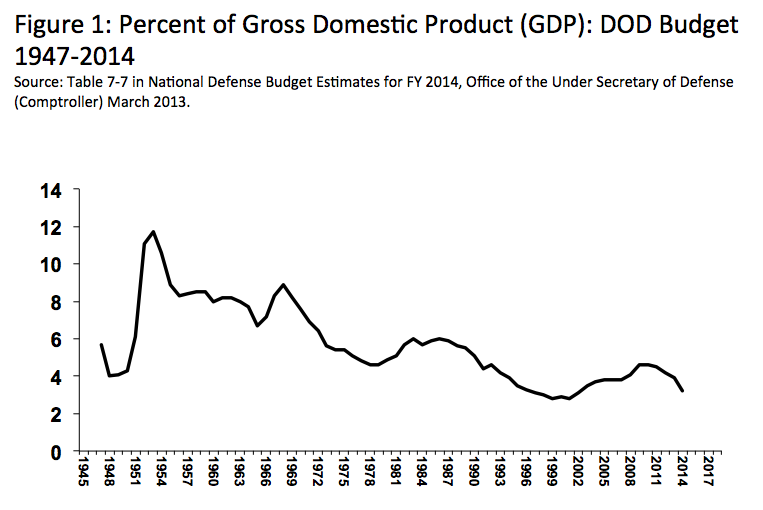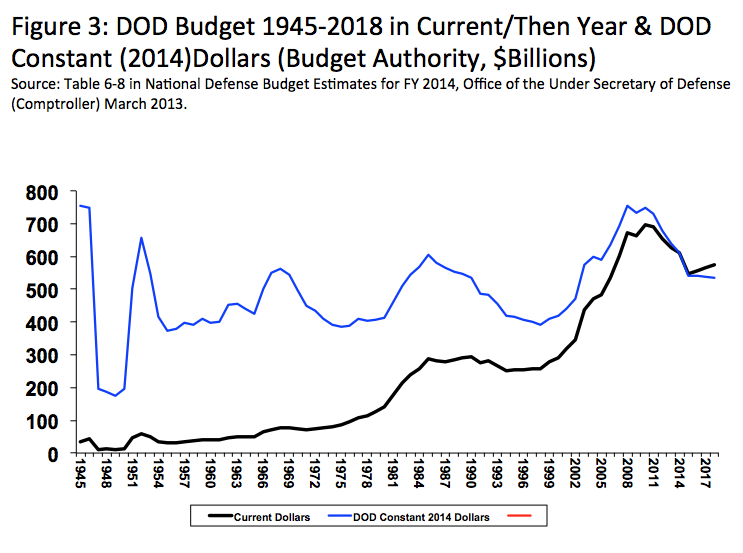The Defense Budget Is Even Larger than You Think: Part one of two.
The Pentagon’s budget has increased, over time, much more than the Defense Department tells Congress, and the public.
The vast majority of people in Washington who consider themselves experts on the defense budget also have little idea just how large the increases have been.
Using standard, generally-accepted economic measures to keep the value of dollars spent over time on an equal footing,
But except for the final three years of George W. Bush’s presidency, President Obama’s pending military-budget request is larger than any other president’s defense budget, in war or peace, since the death of Franklin Roosevelt in April 1945.
If one were to cut the $612 billion defense budget Obama requested for 2014 by an additional $52 billion — the amount mandated by the Budget Control Act of 2011 and its widely dreaded “sequestration” — Pentagon spending would be hundreds of billions of dollars above what we spent, on average, during the Cold War, when we had much more dangerous enemies to worry about.
It would even surpass by more than $100 billion the average annual amount President Reagan spent on defense.
In Washington, they’re calling such a “sequestered” level of Pentagon spending “dangerously low” and a “doomsday” budget. It’s all a part of the parlor game key players like Rep. Howard “Buck” McKeon, R-Calif., the chairman of the House Armed Services Committee, and former defense secretary Leon Panetta, have played to keep defense spending at historically-high levels.
To explain how their version differs from reality, we start with something called the Green Book published each year by the Pentagon’s comptroller, the building’s top money manager. Titled “National Defense Budget Estimates,” it is only half-jokingly described as the “bible” of defense budget analysts.
The Green Book has tables going to the 1940s, and it slices and dices the numbers in all sorts of ways to make it handy, and universally used. However, large swaths of this budget geeks’ bible are misused more for the idolatry of high spending than any monkish reflection.
The favorite data of those who believe more is never enough are in Table 7-7 of the Green Book.
They like to cite the data there that detail the share of the nation’s gross domestic product (GDP) dedicated to the Pentagon as evidence that today’s defense budget is too small — even smaller than during the Cold War — and slipping to historically unprecedented lows, as you can see in this Figure 1 chart.
Note how the graph shows we are now near a post-World War II low, and the current trend is hurtling fast even further downward. Surely, defense-spending boosters argue, this dangerous trend needs to be reversed.
These data, while technically accurate, are misused to make a bogus argument.
These numbers aren’t based on money actually spent, but instead represent the sum of annual Pentagon spending as a slice of the total American economy. Because the American economy has grown faster than defense spending since World War II, the ratio yields numbers that show us dedicating 3.2% of the national economic pie to the military in 2014, compared to a 5.9% slice in 1985 during the Reagan-era defense buildup.
That’s true, but it’s also irrelevant. The key fact is that we are now spending more on our military than during the Reagan Administration.
For example, this percent of GDP measure obscures the fact that, from 1985 to 1986, the percent of GDP spent on defense rose from 5.9% to 6.0%, while defense spending went down from $287 billion in 1985 to $281 billion in 1986.
The economy shrank that year; the defense budget also shrank, but less so. As a result, the ratio showed an increase. The reverse can also happen: if the defense budget goes up and the economy goes up even more, which has been the trend, the percent of GDP measures will show an illusory “shrinkage” in defense spending.
Percent of GDP is an economist’s measure of relative growth, useful to them for technical purposes. However, others like to use the measure because it depicts what they want you to see. Ignore them; they are quacks and charlatans.
Others may want you to see the dollars appropriated to the Pentagon each year. Those data are shown in Figure 2; they are from table 6-8 of the Green Book.
Seen here, the defense budget has grown immensely over time. More recently, it has been coming down, but even after a sharp reduction yet to come in 2015, the defense budget will remain higher than any year before 2006.
However, as any defense-budget analyst worth her or his FYDP will proclaim, the dollars shown in Figure 2 all have a different purchasing value: the buying power of the dollars appropriated at the end of World War Two ($34 billion in 1945) had a buying power very different from the dollars requested by Obama for 2014 ($612 billion). So much so, that if we adjust for the effects of inflation, and equalize the purchasing power of appropriated dollars across fiscal years, the $34 billion appropriated for 1945 had a buying power even higher than the $612 billion sought for 2014.
Conveniently, the Green Book calculates what value dollars from past years would have if they were expressed in today’s value. Table 6-8 shows not just the amounts appropriated in any given year (termed “Current Year” dollars); it also shows the yearly amounts with the value of all dollars adjusted to their value in 2014 (called “Constant” dollars). That way, people can see an apples-to-apples comparison of contemporary defense budgets with those of the past — and even of the future.
The “Constant” 2014-value dollars are shown in Figure 3—along with the “Current Dollar” values for comparison purposes.
Note how the reductions currently projected for 2015 (that nadir after 2010) does indeed show a “real” decline that returns us to spending levels of about 10 years ago. Note also that this reduced level is significantly exceeded by most of the Reagan era and the Vietnam and Korean wars. Even if it does not get as low as past low points, the decline is significant.
However, the Defense Department uses specious formulas to measure the inflation it says its budgets experience.
This was revealed in the 1980s when the Congressional Military Reform Caucus released a study, later confirmed by a pair of Government Accountability Office reports, here and here: the Pentagon claimed it was experiencing more inflation than the rest of government and the economy and extracted almost $40 billion more in appropriations.
The disclosures by the caucus and GAO forced the Pentagon to make some adjustments to its calculation of inflation, especially for procurement, but the adjustments did not remove all the self-serving bias. In 2011, the Straus Military Reform Project released a new study describing the continuing nature of the problem.
Unfortunately, neither Congress — nor any executive-branch official — has required the Pentagon to address the continuing problem, and to live by any measure other than what it concocts for itself to its own budgetary advantage.
Which generates an interesting question that we’ll address in part 2, on Tuesday: what would the defense budget look like if the Pentagon had to live by the same inflation rules as everybody else?
Part 1: Cooked books tell tall tales
Part 2: Correcting the Pentagon’s distorted budget history





